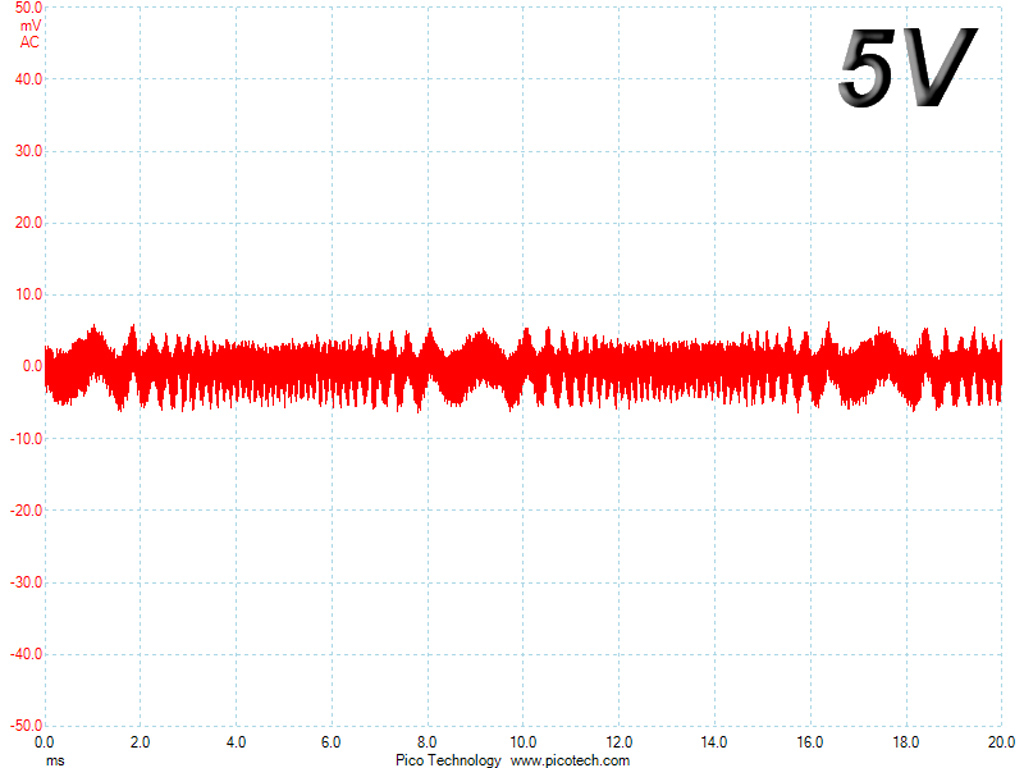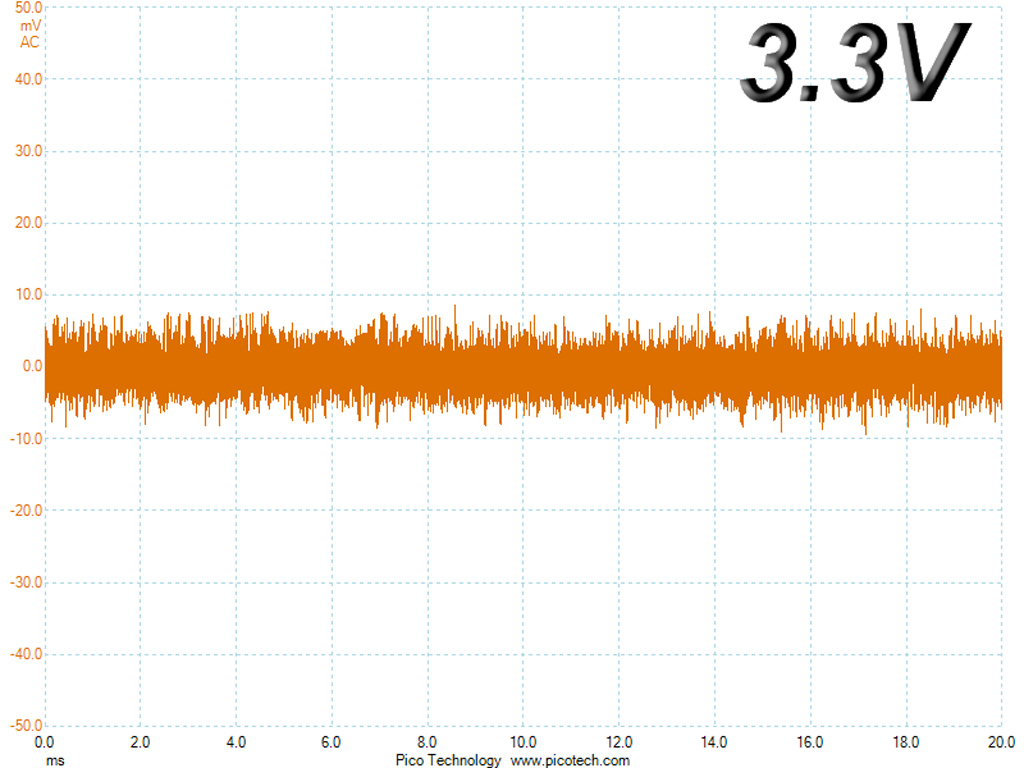Corsair SF600 Power Supply Review
We recently evaluated Corsair's SF450, which left a good impression on us. Now it's time to test the family's flagship SF600, which can deliver 150W more power using exactly the same cable configuration.
Why you can trust Tom's Hardware
Ripple Measurements
To learn how we measure ripple, please click here.
The following table includes the ripple levels we measured on the SF600's rails. The limits, according to the ATX specification, are 120mV (+12V) and 50mV (5V, 3.3V and 5VSB).
| Test | 12V | 5V | 3.3V | 5VSB | Pass/Fail |
|---|---|---|---|---|---|
| 10% Load | 12.7mV | 6.4mV | 9.1mV | 6.3mV | Pass |
| 20% Load | 15.9mV | 7.0mV | 9.0mV | 6.3mV | Pass |
| 30% Load | 16.4mV | 7.7mV | 9.5mV | 6.6mV | Pass |
| 40% Load | 17.1mV | 7.5mV | 11.0mV | 6.7mV | Pass |
| 50% Load | 19.4mV | 7.9mV | 10.5mV | 7.4mV | Pass |
| 60% Load | 23.2mV | 8.2mV | 11.1mV | 7.8mV | Pass |
| 70% Load | 22.4mV | 8.8mV | 13.4mV | 7.9mV | Pass |
| 80% Load | 23.0mV | 10.7mV | 15.2mV | 8.9mV | Pass |
| 90% Load | 24.5mV | 11.7mV | 17.2mV | 8.7mV | Pass |
| 100% Load | 24.2mV | 13.3mV | 21.3mV | 10.7mV | Pass |
| 110% Load | 25.7mV | 13.7mV | 21.8mV | 10.7mV | Pass |
| Cross-Load 1 | 16.3mV | 12.0mV | 18.8mV | 8.9mV | Pass |
| Cross-Load 2 | 25.7mV | 11.6mV | 13.7mV | 9.4mV | Pass |




Ripple suppression is very good, especially when we consider the SF600's compact dimensions that invariably limit the platform's design. Great Wall did a great job here (under Corsair's guidance, of course).
Ripple Oscilloscope Screenshots
The following oscilloscope screenshots illustrate the AC ripple and noise registered on the main rails (+12V, 5V, 3.3V and 5VSB). The bigger the fluctuations on the screen, the bigger the ripple/noise. We set 0.01V/Div (each vertical division/box equals 0.01V) as the standard for all measurements.
Ripple At Full Load




Ripple At 110-Percent Load




Ripple At Cross-Load 1




Ripple At Cross-Load 2




Get Tom's Hardware's best news and in-depth reviews, straight to your inbox.
Current page: Ripple Measurements
Prev Page Transient Response Tests Next Page Performance, Performance Per Dollar, Noise And Efficiency Ratings
Aris Mpitziopoulos is a contributing editor at Tom's Hardware, covering PSUs.
-
dudmont Are these small SFX designed for systems with ITX boards? I understand your complaints about the 8 pin cpu cables, but your complaints about PCIe cables doesn't make sense in light of the fact that no ITX board can handle more than one card. If you're using a micro-atx board, you can use a standard size PSU.Reply -
powernod Wait a moment. Only 2 pci-e cables with 1 connector each one? That means that only one high-end GPU can be supported.Reply
Just like Aris said, what is the reason to go from the SF450 to the SF600, if you can't put another GPU?
+150 watts only to feed SATA devices???!! -
LePhuronn ReplyA 600W PSU can drive a couple of high-end graphics cards and an overclocked CPU. But with only two PCIe connectors, the SF600 natively supports just one enthusiast-class GPU
Yeah, because this PSU is intended to power top-end Mini ITX systems which can only run a single GPU. I thought that was obvious, or is there some standard requirement to review a component entirely in isolation without considering its application? -
LePhuronn ReplyWait a moment. Only 2 pci-e cables with 1 connector each one? That means that only one high-end GPU can be supported.
Just like Aris said, what is the reason to go from the SF450 to the SF600, if you can't put another GPU?
+150 watts only to feed SATA devices???!!
Headroom. I'm current running an original Titan and i5 2500 on Silverstone's ST45-G modualr PSU, and I'm only overclocking the Titan. However, I'm moving the Titan to a new build with a i7 6700K and I don't feel too comfortable pushing both the CPU and the GPU as far as they'd go with only 450W. I'd have no worries with a 600W. -
g-unit1111 Reply17905577 said:Are these small SFX designed for systems with ITX boards? I understand your complaints about the 8 pin cpu cables, but your complaints about PCIe cables doesn't make sense in light of the fact that no ITX board can handle more than one card. If you're using a micro-atx board, you can use a standard size PSU.
Yes. They're designed to work in ultra compact cases like the Silverstone Raven RVZ01B, RVZ02B, as well as the Fractal Design Node 202. I think Corsair is even releasing their own ultra compact case at some point. But the trend is that cases are getting smaller, not bigger. Sure there will always be a market for ATX and EATX, but with Steam Box, you will start to see more of a demand for this type of case. With each generation from here on out, you'll see single cards be just as powerful as a dual card system. So you can get by with no SLI. -
turkey3_scratch Great Wall really is great. It's incredible that this compact unit blows most 600W units out of the water. It's not so much as "headroom" but if you take this PSU vs the SF450, and put that PSU on a machine with the same load, which will have the lower ripple and tighter voltage regulation? The SF600.Reply -
jimmysmitty Reply17905717 said:Wait a moment. Only 2 pci-e cables with 1 connector each one? That means that only one high-end GPU can be supported.
Just like Aris said, what is the reason to go from the SF450 to the SF600, if you can't put another GPU?
+150 watts only to feed SATA devices???!!
A 980Ti is recommended, by nVidia, to have a 600W PSU and that is for the stock 1000MHz speed 980Ti. If we consider the fact that the majority of 980Tis come stock with 10-20% overclocks then a 600W SF PSU would be preferable for a high end ITX build. I can tell you a lot of people throw 980Tis into ITX builds. -
turkey3_scratch Also let's not forget peak efficiency at 50% of a power supply's capabilities, so the SF600 is ideal for that.Reply -
RedJaron Peak efficiency may be around 50% load, but you're forgetting that this is an 80 Gold unit. While it's at least 90% efficient at 50% load ( the graphs looks to be a bit above that ), it's still ( at least ) 87% efficient at 90% load. You're only losing about 5% efficiency between the two here. That only means it draws a few more watts from the wall. Delivery inside the case remains unchanged.Reply
GPU mfrs' recommended PSU capacities are always inflated to compensate for the mediocre ( or worse ) PSUs that flood the mainstream and OEM space. A 980 Ti will pull at most 250W - 275W, depending on OC, during a heavy gaming load. Torture tests can go above 300W, but no one mines with an ITX box. Adding the 130W you'll see from the rest of a typical i7 system, you'd rarely see this go above 400W. That's an 88% load on a 450W PSU. Tight, but certainly not risky or dangerous. As I constantly remind people, my i7 + 290X test bed runs just fine on a 500W PSU, and that GPU is a lot hungrier than the 980 Ti.
The only legitimate use for this PSU, with it's 600W but very limited cables, that I can think of is a heavily OC'd ITX gaming box built in a case that requires an SFX PSU. I can't find a single Z170 or X99 ITX board that has more than an 8-pin CPU power connector, so the PSU's limitation there shouldn't matter. Split the load 300W for the GPU, 250W for the CPU and rest of the system and you duck in just under the power limit. But again, that only makes sense if you MUST use a SFX PSU. Plenty of small cases support full size ATX units, where you have a lot more selection.
This feels as though either Corsair is trying to fleece some customers into spending more than necessary or they got lazy in expanding a product line by increasing capacity without also taking the trouble to re-tool the cabling. -
Aris_Mp In my opinion a 600W PSU (even an SFX one) should have 4x PCIe connectors, because VGAs like the GTX970 and GTX980 consume 160W-200W at worst case scenario, so a couple of them can be easily supported.Reply